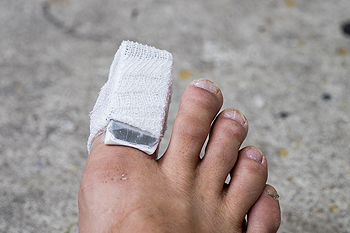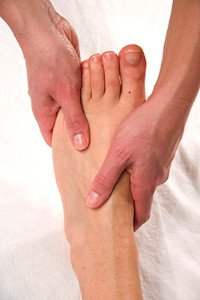 If you have ever experienced a broken toe, you are most likely familiar with the pain and discomfort that is associated with it. Despite the small size of the bones the toes are comprised of, they are necessary in maintaining proper balance, while walking and running. There are several symptoms that are indicative of a broken toe, including bruising, swelling, tenderness, and redness. Many people will notice pain that does not dissipate, and may become worse if left untreated. For severely fractured toes, the bone may be displaced and protrude from the area where the break occurred. A proper diagnosis must be obtained, and this can be accomplished by having an X-ray performed and will often be followed by a physical examination. There are several ways to treat a broken toe, and it’s suggested to speak with a podiatrist who can offer correct treatment options.
If you have ever experienced a broken toe, you are most likely familiar with the pain and discomfort that is associated with it. Despite the small size of the bones the toes are comprised of, they are necessary in maintaining proper balance, while walking and running. There are several symptoms that are indicative of a broken toe, including bruising, swelling, tenderness, and redness. Many people will notice pain that does not dissipate, and may become worse if left untreated. For severely fractured toes, the bone may be displaced and protrude from the area where the break occurred. A proper diagnosis must be obtained, and this can be accomplished by having an X-ray performed and will often be followed by a physical examination. There are several ways to treat a broken toe, and it’s suggested to speak with a podiatrist who can offer correct treatment options.
Broken toes may cause a lot of pain and should be treated as soon as possible. If you have any concerns about your feet, contact Dr. Barbara Kilkenny from Barbara A. Kilkenny, DPM. Our doctor will treat your foot and ankle needs.
What Is a Broken Toe?
A broken toe occurs when one or more of the toe bones of the foot are broken after an injury. Injuries such as stubbing your toe or dropping a heavy object on it may cause a toe fracture.
Symptoms of a Broken Toe
Although the injured toe should be monitored daily, it is especially important to have a podiatrist look at your toe if you have severe symptoms. Some of these symptoms include worsening or new pain that is not relieved with medication, sores, redness, or open wounds near the toe.
If you have any questions, please feel free to contact our office located in Southbury, CT. We offer the newest diagnostic and treatment technologies for all your foot care needs.
Read more about What to Know About a Broken Toe Improper shoe fitting can lead to many problems such as bunions, corns, and hammertoe. ill-fitting shoes can also lead to muscular imbalances in the body, which can eventually lead to hip and knee injuries. A perfectly fitting shoe should not have any excess material that may interfere with the foot’s natural motion. Many runners tend to wear shoes that are too small for their feet. If you are looking to purchase a new pair of shoes, be aware of the fact that your foot is at its widest at the toes, even though many shoes are not. You should also be mindful of the fact that your foot will spread up to half an inch in length when you are running. If you are experiencing problems with your feet due to poorly fitting shoes, you may want to schedule an appointment with your podiatrist.
Improper shoe fitting can lead to many problems such as bunions, corns, and hammertoe. ill-fitting shoes can also lead to muscular imbalances in the body, which can eventually lead to hip and knee injuries. A perfectly fitting shoe should not have any excess material that may interfere with the foot’s natural motion. Many runners tend to wear shoes that are too small for their feet. If you are looking to purchase a new pair of shoes, be aware of the fact that your foot is at its widest at the toes, even though many shoes are not. You should also be mindful of the fact that your foot will spread up to half an inch in length when you are running. If you are experiencing problems with your feet due to poorly fitting shoes, you may want to schedule an appointment with your podiatrist.
Finding a properly-fitting shoe is important in reducing injuries and preventing foot problems. For more information about treatment, contact Dr. Barbara Kilkenny from Barbara A. Kilkenny, DPM. Our doctor will treat your foot and ankle needs.
Proper Shoe Fitting
A common concern when it comes to foot health, having properly fitted shoes can help prevent injuries to the foot. Out feet affect our posture and gait, which in turn affects the biomechanics and overall bodily structure. With 33 joints, 26 bones, and over 100 ligaments, the potential for serious injury is much greater than one realizes. Although the feet cease growth in adulthood, they still change shape as they mature. Here are some factors to consider when it comes to investing in proper fitting shoes:
Keeping in mind how shoes fit the biomechanics of your body, properly-fitting shoes are vitally important. Fortunately, it is not difficult to acquire footwear that fits correctly. Be sure to wear shoes that support the overall structure of your body. Do your feet a favor and invest in several pairs of well-fitted shoes today.
If you have any questions please feel free to contact our office located in Southbury, CT. We offer the newest diagnostic and treatment technologies for all your foot and ankle needs.
Read more about Proper Shoe Fitting A form of arthritis that attacks the joints in the big toe is often referred to as gout. This condition may typically occur abruptly, and obvious symptoms may include severe pain and discomfort, swollen joints, and redness. It develops as a result of excess uric acid in the blood, which can form crystals in the joints. This may occur because of specific foods that are ingested, including an overabundance of shellfish, alcohol, or red meat. Some patients may develop this ailment from inherited genes, being overweight, and taking certain medications. If you are afflicted by this type of arthritis, it’s important that it is treated as quickly as possible, to avoid the development of additional complications. Please speak with a podiatrist about the treatment options that are right for you.
A form of arthritis that attacks the joints in the big toe is often referred to as gout. This condition may typically occur abruptly, and obvious symptoms may include severe pain and discomfort, swollen joints, and redness. It develops as a result of excess uric acid in the blood, which can form crystals in the joints. This may occur because of specific foods that are ingested, including an overabundance of shellfish, alcohol, or red meat. Some patients may develop this ailment from inherited genes, being overweight, and taking certain medications. If you are afflicted by this type of arthritis, it’s important that it is treated as quickly as possible, to avoid the development of additional complications. Please speak with a podiatrist about the treatment options that are right for you.
Gout is a painful condition that can be treated. If you are seeking treatment, contact Dr. Barbara Kilkenny from Barbara A. Kilkenny, DPM. Our doctor will treat your foot and ankle needs.
What is Gout?
Gout is a form of arthritis that is characterized by sudden, severe attacks of pain, redness, and tenderness in the joints. The condition usually affects the joint at the base of the big toe. A gout attack can occur at any random time, such as the middle of the night while you are asleep.
Symptoms
Risk Factors
Prior to visiting your podiatrist to receive treatment for gout, there are a few things you should do beforehand. If you have gout you should write down your symptoms--including when they started and how often you experience them, important medical information you may have, and any questions you may have. Writing down these three things will help your podiatrist in assessing your specific situation so that he or she may provide the best route of treatment for you.
If you have any questions, please feel free to contact our office located in Southbury, CT. We offer the newest diagnostic and treatment technologies for all your foot care needs.
Read more about Gout There are several benefits to the overall health of the feet when the toes are properly stretched. Toes may deform gradually over time as a result of several factors. These may include wearing shoes that are too snug for extended periods of time, improper use of the foot muscles while walking, or standing with the feet pointing outward, which puts pressure on the big toe. When the toes are stretched, the possibility of developing Athlete's foot may diminish as a result of adequate space between the toes. There are simple and effective toe stretches that can be performed daily for optimum results. These may include bending your toes downward to stretch the top of the foot, and taking each toe in your hands while pulling it away from the toe next to it. If you would like additional information about the benefits of stretching your toes, please consult with a podiatrist.
There are several benefits to the overall health of the feet when the toes are properly stretched. Toes may deform gradually over time as a result of several factors. These may include wearing shoes that are too snug for extended periods of time, improper use of the foot muscles while walking, or standing with the feet pointing outward, which puts pressure on the big toe. When the toes are stretched, the possibility of developing Athlete's foot may diminish as a result of adequate space between the toes. There are simple and effective toe stretches that can be performed daily for optimum results. These may include bending your toes downward to stretch the top of the foot, and taking each toe in your hands while pulling it away from the toe next to it. If you would like additional information about the benefits of stretching your toes, please consult with a podiatrist.
Stretching the feet is a great way to prevent injuries. If you have any concerns with your feet consult with Dr. Barbara Kilkenny from Barbara A. Kilkenny, DPM. Our doctor will assess your condition and provide you with quality foot and ankle treatment.
Stretching the Feet
Stretching the muscles in the foot is an important part in any physical activity. Feet that are tight can lead to less flexibility and make you more prone to injury. One of the most common forms of foot pain, plantar fasciitis, can be stretched out to help ease the pain. Stretching can not only ease pain from plantar fasciitis but also prevent it as well. However, it is important to see a podiatrist first if stretching is right for you. Podiatrists can also recommend other ways to stretch your feet. Once you know whether stretching is right for you, here are some excellent stretches you can do.
It is best to go easy when first stretching your foot and work your way up. If your foot starts hurting, stop exercising and ice and rest the foot. It is advised to then see a podiatrist for help.
If you have any questions, please feel free to contact our office located in Southbury, CT. We offer the newest diagnostic and treatment technologies for all your foot care needs.
Read more about How to Stretch Your Feet